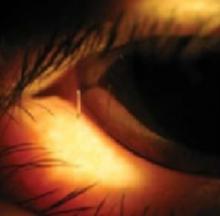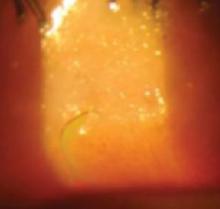CASE 3 Meibomian gland near lower punctum
Eyelash protruding from a meibomian gland orifice 2 mm lateral to the lower punctum.
CASE 4 Meibomian gland
Closer examination of patient shown on page 365 revealed an eyelash projecting out of a meibomian gland orifice toward the ocular surface with corneal punctuate erosions.
Corneal stroma: Suspect trauma
Spontaneously or after trauma, loose eyelashes can penetrate the anterior ocular surface layers by their pointed tip.3,4 These dislodged eyelashes can cause no symptoms at all, or cause foreign body sensation, reflex tearing, and localized erythema mimicking other ocular conditions. Moreover, eyelashes can be washed out into the lower drainage system where they can cause tear stagnation and act as a nidus for dacryolith.5
Considering the history of trauma in CASE 5, we believe the cilium was mechanically embedded on the cornea at the time of injury and got buried as the surface reepithelialized. Examination revealed a corneal opacity containing a horizontally lying cilium. The patient was referred to a cornea specialist for further management.
CASE 5 Corneal opacity
Corneal opacity containing a horizontally lying eyelash.When to suspect a misplaced eyelash
It’s important to examine the eyelid margin carefully in patients with nonspecific eye symptoms, as misplaced eyelashes can be easily overlooked and treated inappropriately. Moreover even in the presence of an obvious pathology, be sure to look for associated findings, especially when that pathology cannot fully explain the symptoms. That was especially important in Case 4, with the rare occurrence of exposure keratopathy in a young patient.
CORRESPONDENCE
Kimia Ziahosseini, MD, Flat 5, 25 Higher Hill Gate, Stockport, Cheshire SK1 3ED United Kingdom. kim.z@doctors.org.uk




